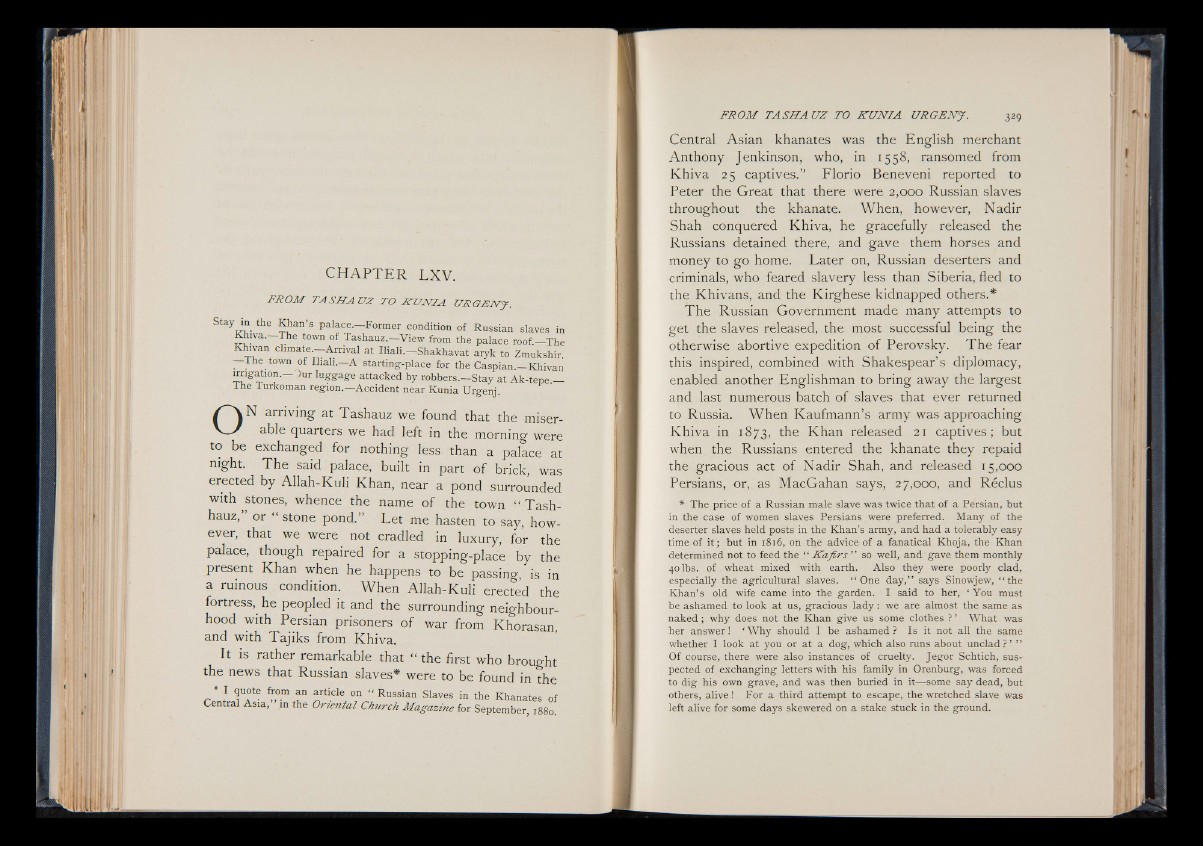
C H A P T E R LX V .
FR OM TA SH A U Z TO K U N IA U RG EN J.
Stay m the Khan’s palace.—Former condition of Russian slaves in
hiva. The town of Tashauz.—View from the palace roof.— The
Khivan climate.—Arrival at Iliali.— Shakhavat aryk to Zmukshir.
— fhe town of Iliali. A starting-place for the Caspian.—Khivan
irrigation— Our luggage attacked by robbers.-Stay at Ak-tepe.-
ihe iurkoman region.—Accident near Kunia Urgenj.
ON arriving at Tashauz we found that the miserable
quarters we had left in the morning were
to be exchanged for nothing less than a palace at
night. T he said palace, built in part of brick, was
erected by Allah-Kuli Khan, near a pond surrounded
with stones, whence the name o f the town “ Tash-
hauz, or “ stone pond.” Let me hasten to say, however,
that we were not cradled in luxury, for the
palace, though repaired for a stopping-place by the
present Khan when he happens to be passing, is in
a ruinous condition. When Allah-Kuli erected the
fortress, he peopled it and the surrounding neighbourhood
with Persian prisoners o f war from Khorasan,
and with Tajiks from Khiva.
It is rather remarkable that “ the first who brought
the news that Russian slaves* were to be found in the
* I quote from an article on “ Russian Slaves in the Khanates of
Central Asia, m the Oriental Church Magazine for September, 1880.
Central Asian khanates was the English merchant
Anthony Jenkinson, who, in 1558, ransomed from
Khiva 25 captives.” Florio Beneveni reported to
Peter the Great that there were 2,000 Russian slaves
throughout the khanate. When, however, Nadir
Shah conquered Khiva, he gracefully released the
Russians detained there, and gave them horses and
money to go home. Later on, Russian deserters and
criminals, who feared slavery less than Siberia, fled to
the Khivans, and the Kirghese kidnapped others.*
The Russian Government made many attempts to
get the slaves released, the most successful being the
otherwise abortive expedition of Perovsky. T h e fear
this inspired, combined with Shakespear’ s diplomacy,
enabled another Englishman to bring away the largest
and last numerous batch of slaves that ever returned
to Russia. When Kaufmann’s army was approaching
Khiva in 1873, the Khan released 21 captives; but
when the Russians entered the khanate they repaid
the gracious act of Nadir Shah, and released 15,000
Persians, or, as MacGahan says, 27,000, and Reclus
* The price of a Russian male slave was twice that of a Persian, but
in the case of women slaves Persians were preferred. Many of the
deserter slaves held posts in the Khan’s army, and had a tolerably easy
time of it; but in 1816, on the advice of a fanatical Khoja, the Khan
determined not to feed the “ K a firs ” so well, and gave them monthly
40 lbs. of wheat mixed with earth. Also they were poorly clad,
especially the agricultural slaves. “ One day,” says Sinowjew, “ the
Khan’ s old wife came into the garden. I said to her, ‘ You must
be ashamed to look at us, gracious lad y: we are almost the same as
naked; why does not the Khan give us some clothes ? ’ What was
her answer! ‘ Why should I be ashamed ? Is it not all the same
whether I look at you or at a dog, which also runs about unclad ? ’ ”
Of course, there were also instances of cruelty. Jegor Schtich, suspected
of exchanging letters with his family in Orenburg, was forced
to dig his own grave, and was then buried in it—some say dead, but
others, alive ! For a third attempt to escape, the wretched slave was
left alive for some days skewered on a stake stuck in the ground.